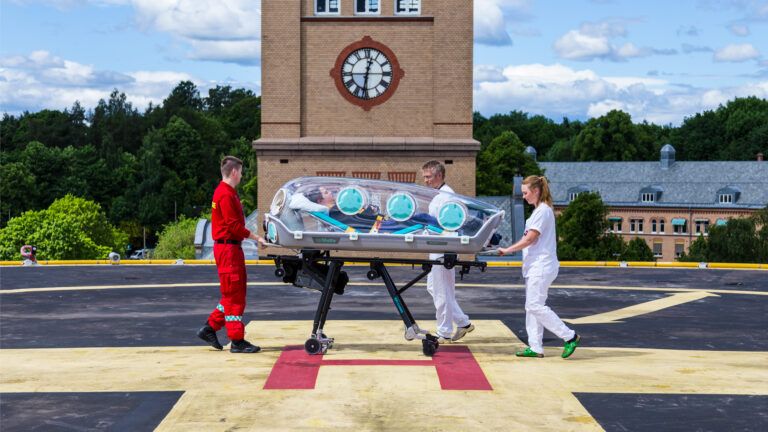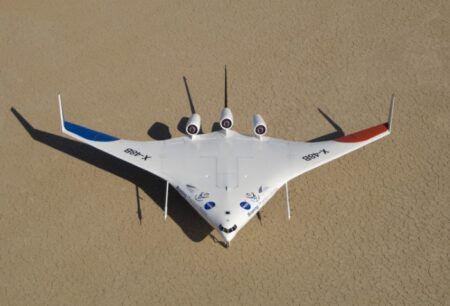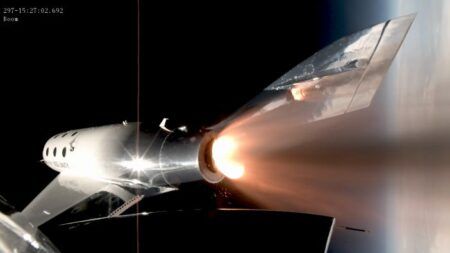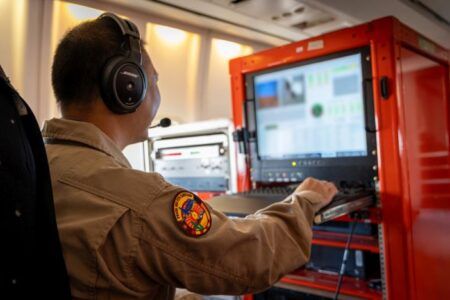Words by Paul Willis
During the past two years medical air transportation has come in to focus because of Covid-19. Air ambulance services around the world have borne the burden of transporting Coronavirus patients.
In May 2020, at the height of the pandemic, air ambulance services were so pressed that Prince William offered the use of his private lawn at Kensington Palace as a location for them to touch down and refuel.
Royal interventions aside, the pandemic also led to a surge in demand for on-board medical equipment. The Norwegian medical equipment maker EpiGuard experienced a 2,000% increase in sales for its EpiShuttle isolation pods to transport Covid-19 patients.
Three of those sales went to the German air ambulance operator FAI. “We own and operate three EpiShuttles that were purchased during 2020 and 2021,” says Volker Lemke, FAI’s chief strategy officer.
Since the Epishuttles’ purchase, says Lemke the pods have been used in 165 patient transports with “the majority of them on long-distance routes with transport times of between 12 and 24 hours.”
FAI, which has a fleet of fixed-wing aircraft that includes Bombardier Learjets and Challengers, only uses the EpiShuttles on the larger Challengers “due to the EpiShuttle’s rather large dimensions,” says Lemke.
Size was one of the main factors that influenced the design of the device, says Fridtjof Heyerdahl, an air ambulance doctor and the creator of the EpiShuttle, who is now the company’s chief medical officer. “The larger the device the better it is for the patient. But the smaller the device, the easier it is to get on board aircraft,” he says. “So we had to make a trade-off between being able to fit it on as many aircraft as possible and it being big enough for patients.”
Quarantined in flight

The idea for the EpiShuttle came to Heyerdahl following the Ebola outbreaks in West Africa in 2014. Heyerdahl was part of team tasked with repatriating Norwegians from the affected areas and discovered during the work that the existing equipment for transporting contagious patients safely was inadequate. When designing the EpiShuttle they found that there was few industry benchmarks for them to work from. “There were no specific standards for the structure and size of these kinds of isolation pods,” says Heyerdahl.
While standard dimensions exist for ambulance stretchers, these dimensions were designed for road ambulances not aircraft, and do not take account of the three-dimensional structure of the isolation pod.
The EpiShuttle’s height is especially challenging for side-loading on to aircraft that don’t have a rear entrance, says Heyerdahl.
To help overcome this problem he designed the pod with rounded ends to make it more maneuverable. The rounded ends also help make the patient’s head more accessible for emergency responders offering medical care throughout the duration of the flight.
“The most important thing was to design it in a way that would allow me to treat the patient with intensive care,” says Heyerdahl. “So I can have the mechanical ventilator and syringe pumps running through the pod.”
The design also had to allow for sudden changes in cabin pressure, which can compromise the device’s ability to keep contaminated air inside the pod. In normal circumstances a leakage of contaminated air is prevented through the use of a fan, which sucks filtered air out of the device, thus ensuring a negative air pressure inside the device compared to the outside.
This negative air pressure means that clean air is pulled into the pod while only filtered air escapes. But if a sudden drop in cabin pressure leads to “a positive pressure difference inside then you could have a situation where you have a leakage of contaminated air from the inside to the outside,” says Heyerdahl.
To prevent this a special filter was fitted in to the air inlet to stop contaminated air escaping.
The development of the EpiShuttle also had to account for how it would be hosted on board the aircraft. EpiGuard partnered with the manufacturers of stretcher systems to ensure the pod could be secured to existing restraints on the aircraft.
Aircraft integration
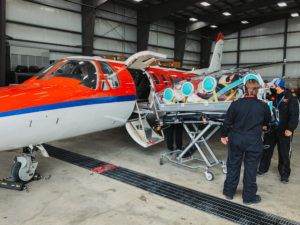
In the case of European air ambulance operator FAI, ground plates were fitted to the floor “to allow for the optimum mounting of the EpiShuttle in the aircraft,” says EpiGuard’s CEO Ellen Cathrine Andersen.
While the EpiShuttle was designed for air ambulances, the most common use of on board medical equipment is in commercial aviation. Nearly every commercial aircraft, as well as business jet carries medical equipment.
While there is no global set of standards for an on board medical equipment, the International Civil Aviation Organization (ICAO) has published a set of general guidelines that states use to develop their own regulations.
“Ultimately this is defined at the country level,” says Paulo Alves, global director of aviation health at MedAire, a provider of medical equipment and services to the aviation industry. “And some choose to go above and beyond the minimum standards.”
Alves gives the example of the USA, where commercial carriers have been required since 2001 to carry automated external defibrillators (AEDs) on board flights. In Europe a requirement to carry AEDS only came in last year.
Besides AEDs, commercial aircraft carry medical kits. According to Alves, the contents of these kits are dictated by two main factors: severity and frequency.
“A way to understand in-flight medical events is to look at the severity of the situation versus its frequency,” says Alves. “There are no medical events that are life threatening and frequent.”
Instead, he says, in-flight medical events are either common but non-life threatening or infrequent but life threatening: “So cardiac arrests are rare, however they do occur. And if they occur the only hope is to have an AED. So, we need to have AEDs.”
For this reason, he says, most European carriers were already carrying AEDs before the recent EU mandate. Another rare but life threatening event is serious allergic reactions, and for this reason most flight medical kits contain epinephrine autoinjectors, better known as epipens.
Among the common medical emergencies, says Alves, are travelers “getting sick and vomiting, so you need to have drugs to address that.”
Certification
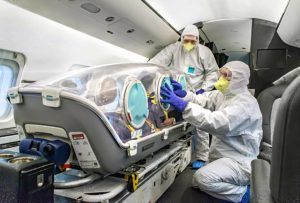 Once the question of what equipment to carry on-board has been resolved, commercial aircraft operators need to consider certification requirements. According to Michael Andorka, head of continuing airworthiness management at FAI, there are only two circumstances where on-board medical equipment needs aviation certification above and beyond the medical certification it already has.
Once the question of what equipment to carry on-board has been resolved, commercial aircraft operators need to consider certification requirements. According to Michael Andorka, head of continuing airworthiness management at FAI, there are only two circumstances where on-board medical equipment needs aviation certification above and beyond the medical certification it already has.
This is either when the medical equipment has “to be attached to the aircraft structure” or when “the equipment could cause electromagnetic interference” with the aircraft’s electronics systems, says Andorka.
In commercial aviation, therefore, it is usually only electronic devices like AEDs that need to be certified for electromagnetic compatibility (EMC). In the US, for example, defibrillators need to be certified in line with the FAA’s technical standard orders (TSO).
Other on-board electronic devices that are subject to certification requirements include the Tempus IC2, a vital signs monitor for non-medical experts that Medaire includes in its kits. A multi-parameter monitor capable of measuring blood pressure, pulse and electrocardiograms, the Tempus and its batteries need to comply with FAA and EASA EMC requirements.
In the case of air ambulances, where the volume and complexity of the medical equipment is much greater than in commercial aviation, certification is more likely to be required. In the case of the EpiShuttle, EASA’s specifications on certification have ruled that installation of the device on board an aircraft constitutes “a major change,” says Andorka.
Consequently, FAI were obliged to obtain supplementary type certification for the installation of the isolation pods on board their fleet of Challengers.
For the EASA certification the EpiShuttle had to undergo three different tests – a flammability test, a rapid decompression test and a patient evacuation.
While the flammability test was carried out in a laboratory, for the rapid decompression test a pressure chamber was used at a test center located near Munich, says Andorka.
“We repeated the test twice at different altitudes,” says Andorka. “After each test we checked the EpiShuttle’s structural integrity and function according to certain criteria.”
The patient evacuation, meanwhile, was carried out at FAI’s home base in Nuremberg and was supervised by an EASA test engineer and observed by an EASA cabin safety expert, he says.
According to the regulator’s specifications it had to be possible to evacuate a patient within 90 seconds in an emergency. During the test, FAI employees managed to evacuate the patient in just under a minute.
FAI Air Ambulance has invested a total of US$65,000 in the testing and obtained the supplementary type certification for the EpiShuttle late last year.
At the height of the pandemic the urgency of the medical crisis meant that there was no time to pursue certification. Instead, says Andersen, EASA developed “guidelines for national competent authorities to issue exemptions for transport isolation devices and other medical equipment during the pandemic.”


